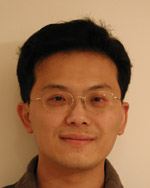
 |
 |
 |
 |
|
| Ching-Yung
Lin -- Projects |
|||
|
|
|||
|
|
[ This page is under construction!!
] HUMAN
INFORMATICS AND SOCIAL COMPUTING
Social
Computing is to study
Human/Social Attributes and Dynamics through observable
data using multimodality signal understanding techniques. Social
Computing aims at (1) modeling and predicting human behavior
via computer, and (2) objectively interpreting observations for social
science
researchers. We shall work closely with social scientists as well as
biomedical
scientists to achieve these goals. In ancient philosophy,
there
was no difference between studying mathematics, history, poetry or
politics.
Aristotle studies planetary motion and poetry with the same methods,
and Plato
mixes geometrical proofs with his demonstration on the state of
intrinsic
knowledge. Only when the mathematical proof methodology arises over
centuries,
there becomes a perceived difference between natural scientific fields
and
humanities fields. Humanities fields suffer from the difficulty of
objective
and repeatable experiments that arouses a longstanding argument that
whether
"social science" belongs scientific disciplines. However, similar
perceptions can change. For instance, biology -- before Video understanding is an
important media to interpret human behavior. Sociologist would like to
see more
subjective perceptions being pinned down by more objective
measurements. In a
Pedagogy study, for instance, researchers would like to understand
which
teaching method can improve the interaction of teacher-students or how
to
effectively teach minority students. Usually, they record classroom
videos for
3 months to a year and watch them recursively to support their
hypotheses.
Another example is, at political science study, researchers would like
to find
out how public consensus is formed through the interaction of people in
a
meeting. Usually, they need to observe large amount of videos to answer
questions like: (1) Will highly educated people show their opinions
more than
those with lower education?, (2) Will people with lower education
modify their
thoughts according to other people's opinions more easily than highly
educated
ones?, (3) Will the final meeting result/conclusion consistent with the
opinion
of people who dominate the meeting?, and (4) To what level the meeting
conclusion will be driven by the shown-up emotion?
In above cases, visual understanding
techniques can detect emotions and human interaction types, speech
recognition
and text understanding can detect the educational level of participants
and the
influence chains of attendees’ opinions, and face recognition
techniques can
identify people. These techniques shall objectively convert high volume
videos
into semantic indices that will be easily transcribed, searched and
further interpreted
by researchers. Using mostly text-based
data, such as emails, web access logs, instant messages, publications,
etc, is
another important way to understand humanity. Krackhardt showed that
companies
with strong informal networks perform five or six times better than
those with
weak networks, especially on the long-term performance. Friend and
advice
networks drive enterprise operations in a way that, if the real
organization
structure does not match the informal networks, then a company tends to
fail.
Since Max Weber first studied modern bureaucracy structures in the
1920s,
decades of related social scientific researches have been mainly
relying on
questionnaires and interviews to understand individuals' thoughts and
behaviors. However, data collection is time consuming and seldom
provides
timely, continuous, and dynamic information. With multimodality
understanding
technologies, we can automatically detect the informal network to
suggest
structure change for more effective organizational management. Understanding human
behavior
can help improving our life quality. As the percentage of the elder
population
continues to rise, advanced health care system has been an active
subject of
many research projects. For health care applications, there are often
critical
needs on recognizing a person’s physical location, condition, and
activity.
Various sensors can be deployed to acquire multimodality data for
recognizing a
user’s contextual information. With the knowledge of a user’s
contextual
information, a personal assistant/recommender or warning system can be
developed to recommend activities for improving long-term health
conditions,
raise alarms for emergency situations, and monitor long-term health
changes via
early-warning detection. In addition to providing
objective scalable observations to social scientists, we also aim to
develop
advanced learning machines to model and predict human and society
behaviors.
For instance, we can allow machines use supervised learning to learn
from the
experience of psychologists towards predicting the marriage status of
couples
through interview videos. Text-based analysis can also be used in
analyzing the
authenticity of arts, e.g., literature, paintings, scientific
publications,
based on its style, e.g., the author of articles, paintings, etc. Understanding human and
society behavior is an important emerging research trend. We call this
research
thread as Social Computing. We see
multidisciplinary research is a must towards its success, and computer
scientists definitely play a critical role. Recently, we found out that
NSF
identified Human and Society Dynamics
as one of its five priorities, among nanoscience technology,
biocomplexisty in
environments, mathematical science, and cyberinfrastructure. We are all
human,
living in societies. We, thus, consider this as a novel field that is
worth
significant investigation. Related
Projects:
|
| About IBM | Privacy | Legal | Contact |